Hydropneumatic flushing and pressure testing of the heating system - technology of work
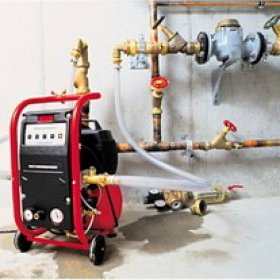
Heating systems are firmly entrenched in life, because they are present in many houses, apartments, and enterprises. Of course, for the system to function for a long time and without fail, it is necessary to carry out certain measures. For this reason, hydropneumatic flushing of the heating system is very relevant: in the publication we will talk about the intricacies of the process, its effectiveness.
Why is it necessary to flush the heating system?
The scum that collects on the walls of the pipes of the batteries causes numerous problems. Firstly, the mechanical wear of pipes is significantly accelerated. Secondly, the heat transfer of the system is significantly reduced, and this is a negative factor. So, experts say that a scale of 1 mm thickness reduces the heat transfer level by 15%, because the thermal conductivity of scale is about forty times less than the similar parameters of the metal. This indicates that even a thin layer of scale damages the metal and can lead to the appearance of fistulas, to rupture of pipes.
In addition, the key indicators of heating are changing in the negative direction. This means that fuel costs are rising and efficiency is falling. As you can see, the consequences are significant, so flushing the heating pipes and radiators is extremely necessary.
The above can be summarized as follows: the main purpose of flushing the heating is to achieve maximum savings in heat and money of the consumer. It must be clearly understood that pipes clogged with various deposits often cause emergencies. Ideally, flushing of radiators and pipelines should be done once a year.
Before performing a range of activities, a system diagnosis should be made. The obtained indicators will show the specialist a complete picture, that is, he will know the composition and nature of the deposits. Based on the results, appropriate equipment will be selected, and after flushing it is necessary to perform anti-corrosion treatment of the pipe walls. Thanks to this procedure, deposits and scale deposits are prevented for some time.
Signs of reduced heating system performance
How to find out what flushing is needed? Among the clear signs of a decrease in the efficiency of the heating system are the following indicators:
- strange, unusual sounds come from the boiler;
- the system heats up for a long time;
- the pipes are hot and the radiator is cold;
- a sharp increase in energy consumption - this fact does not please anyone;
- commissioning of the boiler in the previously used heating system.
If these symptoms occur, urgent measures must be taken to prevent an emergency.
The essence and stages of hydropneumatic flushing
So, what are the rules for flushing the heating system in this way? First, it must be said that such a technology consists in supplying compressed air to pipes filled with water. After carrying out such a process, the speed of movement of the air-water mixture increases and high turbulence is created: as a result, deposits are loosened and removed from the space of the system.
During hydropneumatic flushing, pipes with taps and check valves cut into the pipeline. In a small system, water is supplied through the pipes available in the heating system. To discharge water, a drain pipe must be inserted into the return pipe or special taps should be used. If a system with an elevator is flushed, the elevator cup and cone are previously removed.
To supply air, you need to use a compressor to flush the heating system, which creates a pressure of 0.6 MPa. A non-return valve is installed on the compressed air pipeline - its main task is to limit the ingress of water into the compressor receiver.
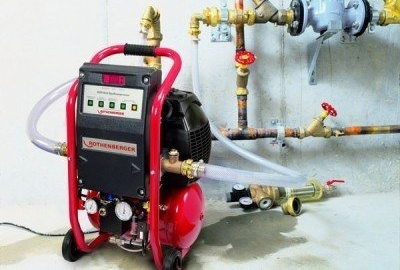
A high-quality compressor cleans the heating system well from all kinds of contaminants. It makes no sense to buy it for one cleaning, but you can rent it
A few words should be said about choosing the right compressor. When making a purchase, you need to focus on the technical characteristics of the product, in particular, on the presence of the function of automatically controlling the frequency of formation of the mixture supply pulses.
Well, if the possibility of adding officially approved disinfectants is provided. Also, the following parameters should be provided in the equipment:
- protection against spontaneous inclusion;
- compactness, mobility;
- the presence of an indicator of the level of pressure, flow rate of flushing water.
And now the instructions for flushing the heating system with the hydropneumatic method will be considered. The first option is the flow method - it consists in carrying out the following steps:
- the system is filled with water, and the air intake valve is in the open state;
- after filling, the valve closes;
- compressed air is supplied with the subsequent opening of the drain pipe;
- the mixture is continuously fed into the pipeline, passes through all devices, and then merges.
Flushing continues until clean water flows from the nozzle.
The method of filling the system (second option) is carried out in the following sequence:
- the system is filled with water, the valve closes;
- compressed air is supplied through another nozzle, after 5-15 minutes, the supply is stopped and water with dirt, exfoliated by blowing, is removed through the discharge nozzle.
The effectiveness of hydropneumatic flushing is obvious:
- reduced hydraulic resistance of pipelines and the system as a whole;
- heat transfer increases, that is, thermal energy is used most productively;
- fluid circulation improves.
It is important to note that hydropneumatic flushing is calculated separately for each system.
Crimping Technology
When the cold season is approaching and the heating season is on the nose, you should take care of an important procedure, that is, check the system for leaks. This process cannot be ignored and special attention should be paid to the pipeline and the pipes entering it. In addition, crimping may be necessary at the height of the heating season if emergency situations have occurred. The reason is that when installing pipes, radiators, a boiler, the tightness of the connecting nodes cannot be fully monitored.
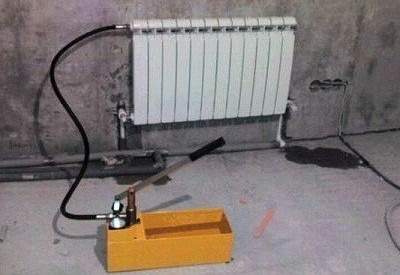
This is what the pressure test pump looks like, which is used to fill the system and to conduct a pressure test
Do-it-yourself pressure testing of the heating system in this order:
- The heating system slowly fills with water. Two points are important here. Firstly, in a house consisting of one or two floors, you do not need to raise pressure. Secondly, when it comes to conducting an inspection in a multi-story building, the press raises the pressure to the appropriate levels;
- A system filled with water is left under pressure for 30 minutes. Throughout this period, the pressure gauge can easily and easily find leak points. If the arrow deviates, and the pressure decreases, then somewhere there is a leak;
- After detecting a leak, the water is drained (in whole or in part), the leak is eliminated and the procedure is carried out again.
Neglecting the crimping process, homeowners risk safety and human health.
Flushing and pressure testing of the heating system are mandatory procedures that must be carried out regularly, without ignoring them and not leaving them for later!

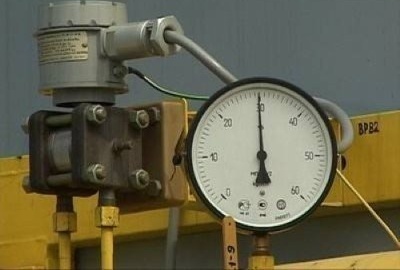
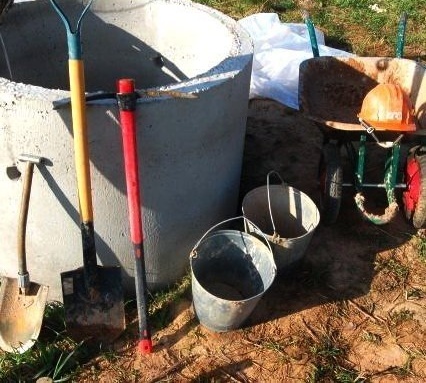
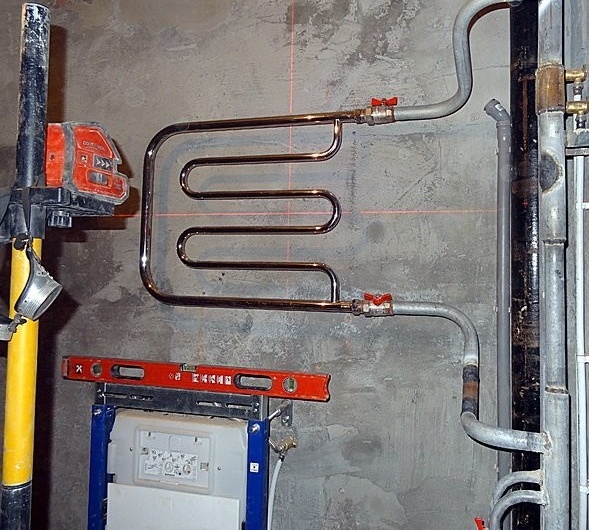
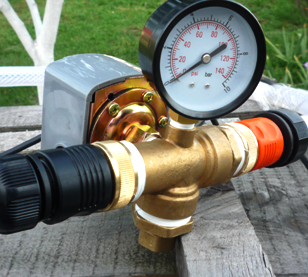
1 comment